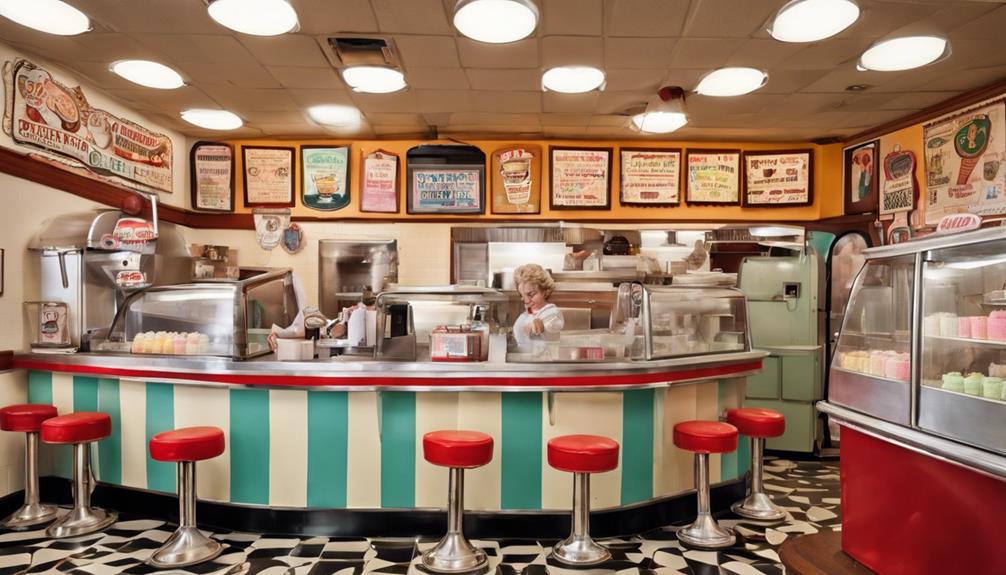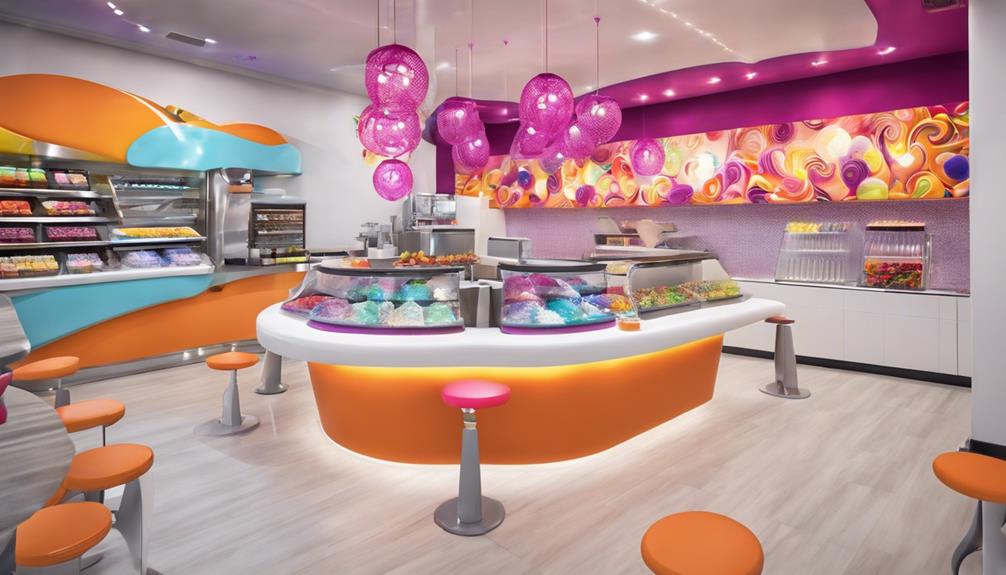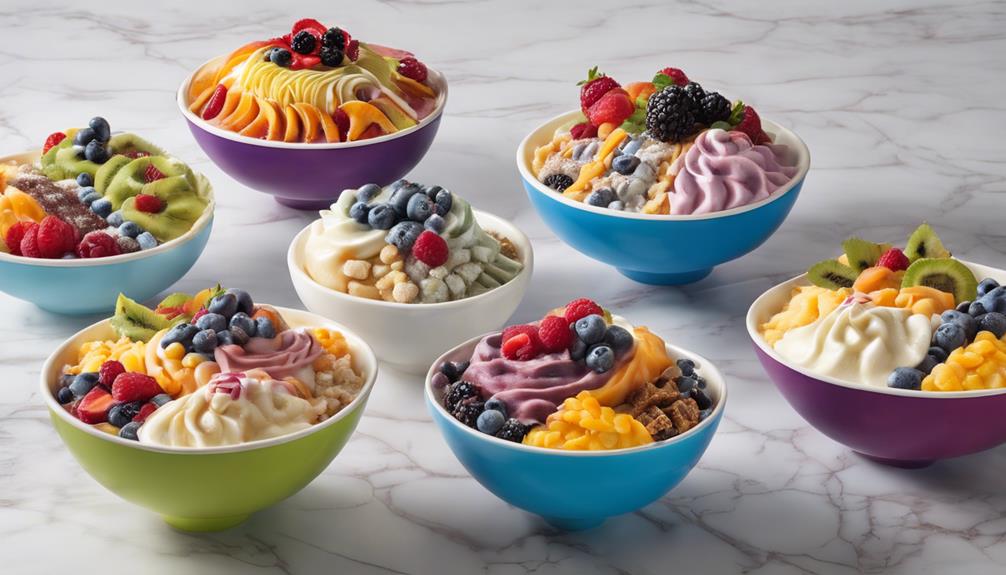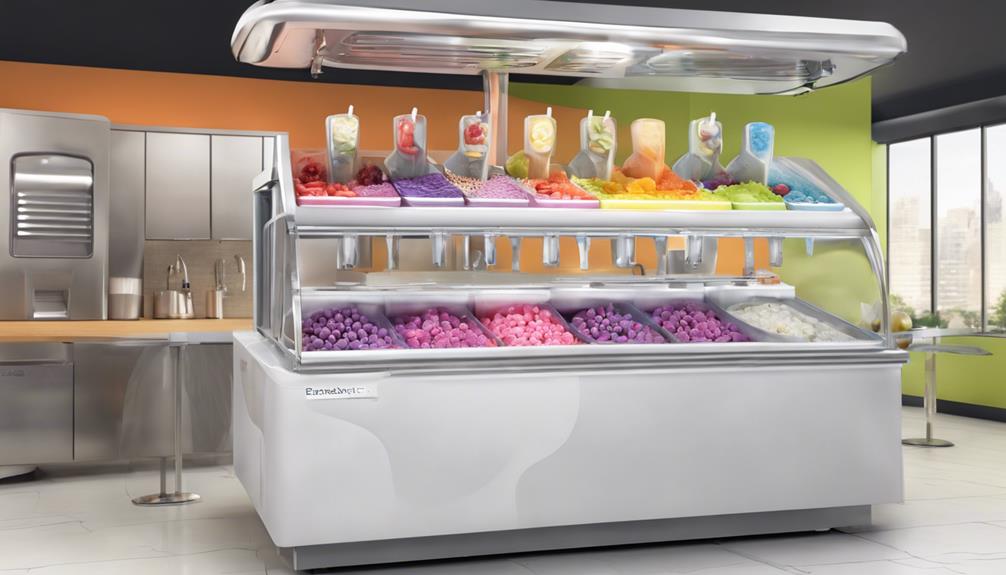You've probably noticed how frozen yogurt shops seem to pop up on every corner, but have you ever wondered how this trend really took off? It all started in the 1970s when H.P. Hood introduced a low-fat alternative to ice cream, tapping into a growing desire for healthier dessert options. This shift didn't just happen overnight. As you explore the factors that contributed to the frozen yogurt boom, from early beginnings to modern innovations, you'll find some surprising twists and turns in its journey to becoming a beloved treat. Ready to discover more about how this frosty delight captured hearts and taste buds alike?
Key Takeaways
- Frozen yogurt introduced in the 1970s as a low-fat alternative to ice cream, responding to increasing health consciousness.
- H.P. Hood's innovation laid the groundwork for the frozen yogurt industry's growth.
- By the 1990s, frozen yogurt captured 10% of the frozen dessert market.
- Brands like Pinkberry and Yogurtland drove significant market expansion in the 2000s.
- The industry's revenue reached $2.1 billion by 2019, despite fluctuations due to health trends and market saturation.
Early Beginnings

The journey of frozen yogurt began in the 1970s when H.P. Hood introduced it as a low-fat alternative to ice cream, setting the stage for a significant shift in the frozen dessert market. Recognizing a demand for healthier dessert options, H.P. Hood's innovation was not just a product but a catalyst for what would become a burgeoning frozen yogurt industry. This first frozen yogurt offered consumers a guilt-free indulgence, directly responding to the increasing health consciousness of the era.
Research suggests that H.P. Hood's introduction laid the groundwork for an industry that would see periods of both decline and resurgence. While the initial reception was modest, the seeds for a 21st-century renaissance were sown. The low-fat alternative appealed to those seeking healthier lifestyles, and this initial market traction hinted at greater potential.
The context of the 1970s and 1980s was instrumental in shaping consumer behaviors that favored frozen yogurt. The health and wellness trends of the time provided fertile ground for the industry to grow. H.P. Hood's pioneering efforts, although not immediately revolutionary, were foundational in setting the stage for the frozen yogurt industry's eventual rise and transformation.
Rise in Popularity
Building on the groundwork laid in the 1970s and 1980s, the frozen yogurt industry saw an impressive surge in popularity with Pinkberry's debut in 2005, igniting a new era of consumer enthusiasm. This resurgence propelled the frozen yogurt market into the spotlight, transforming it from a niche product into a mainstream soft-serve dessert. By the 1990s, frozen yogurt had already captured 10% of the frozen dessert market, but it was the 2000s that truly marked its golden age.
Brands like Pinkberry, Handles, Menchies, Topzz, Llaollao, and Yogurtland emerged as success stories, each carving out a significant share of the market. These brands capitalized on new trends and consumer preferences, particularly the growing demand for healthier dessert options. Frozen yogurt was marketed with various health claims, including lower fat content and probiotic benefits, appealing to health-conscious consumers.
The frozen yogurt market saw significant growth, reaching $2.1 billion in revenue by 2019. This boom was not just about the product but also about creating an experience. Shops became trendy alternatives to traditional ice cream stores, offering customizable toppings and modern, inviting atmospheres that attracted a new wave of consumers.
Expansion of Shops

As the frozen yogurt craze took off in the early 2000s, countless new shops began springing up across the United States, each excited to capitalize on the growing demand for healthier dessert alternatives. This 21st-century boom saw the rapid expansion of chains like Pinkberry, Menchie's, and Yogurtland, which became household names. These frozen yogurt shops proliferated due to their innovative business model and appeal.
Self-serve frozen yogurt shops played a pivotal role in this expansion. By allowing customers to customize their desserts, these shops offered a unique and interactive experience. This self-serve model not only reduced labor costs but also increased customer satisfaction by providing a variety of flavors and toppings to choose from. The ability to tailor one's dessert resonated with health-conscious consumers looking for alternatives to traditional ice cream.
The surge in the number of frozen yogurt shops was fueled by the growing trend of seeking healthier dessert options. Research indicates that consumers perceived frozen yogurt as a guilt-free indulgence, contributing significantly to the industry's growth. Consequently, the expansion of these shops in the early 2000s solidified the frozen yogurt boom, cementing its place in the dessert market.
Health Trends Impact
Health trends played a significant role in both the rise and fall of the frozen yogurt industry, shaping consumer preferences and market dynamics. The initial surge in frozen yogurt's popularity can be attributed to its marketing as a healthier alternative to traditional ice cream. This perception aligned well with the health-conscious trends of the 1980s and early 2000s, driving consumer preferences toward low-fat and probiotic-rich options.
However, the industry experienced a decline in the early 2010s due to oversaturation and the emergence of new food fads. The market became crowded with self-serve frozen yogurt shops, leading to fierce competition and diminishing returns. Oversaturation made it difficult for individual brands to maintain their unique appeal, causing many to shutter.
Moreover, shifting health trends played a pivotal role in this decline. As consumers began prioritizing whole, unprocessed foods over sugary snacks, frozen yogurt's appeal waned. Health trends shifted focus towards organic, plant-based alternatives, leaving the once-thriving frozen yogurt market struggling to keep up. Despite this, some resilient brands adapted to changing consumer preferences, incorporating healthier options and innovative flavors to stay relevant. These adaptive strategies highlight the dynamic interplay between health trends and market viability in the frozen yogurt industry.
Modern Innovations

Modern innovations in the frozen yogurt industry demonstrate a strategic response to evolving consumer demands, introducing exotic flavors and diverse toppings to enhance the overall dessert experience. By incorporating unique flavors such as lavender, matcha, and salted caramel, the industry caters to a wider range of palates, appealing to both adventurous and traditional consumers. This diversification in taste profiles guarantees that frozen yogurt remains a relevant and exciting option in the competitive dessert market.
In addition to introducing new flavors, the frozen yogurt industry has expanded its selection of toppings to include superfoods and gluten-free options. These new toppings not only add nutritional value but also align with contemporary culinary trends that emphasize health and wellness. By offering chia seeds, goji berries, and gluten-free granola, frozen yogurt shops can attract health-conscious customers looking for a guilt-free treat.
Moreover, the industry has made significant strides in providing vegan options, addressing the increasing demand for plant-based and allergen-free desserts. This commitment to inclusivity ensures that frozen yogurt can be enjoyed by a broader audience, including those with dietary restrictions. Continuous innovation in flavors, toppings, and dietary options underscores the industry's dedication to staying current with consumer preferences and culinary trends.
Frequently Asked Questions
What Happened to the Frozen Yogurt Trend?
The frozen yogurt trend declined due to market shifts and changing consumer behavior. Health trends, flavor innovation, and branding challenges influenced this. New food fads and skepticism about health claims further impacted the market.
What Happened to Elan Frozen Yogurt Brigham?
Elan Frozen Yogurt Brigham faced Brigham closure due to evolving product preferences, intense competition impact, and mixed customer feedback. Despite strong Elan branding, the shop couldn't adapt fast enough to market changes, leading to its closure in 2019.
What Happened to Pinkberry Frozen Yogurt?
Pinkberry's branding, customer experience, and menu innovation initially drove success. However, market competition and challenges with international expansion impacted growth. Despite efforts, maintaining its trendy appeal proved difficult in a saturated market.
Is Frozen Yogurt Healthier Than Ice Cream?
Picture a bowl of creamy, cool dessert. Frozen yogurt often edges out ice cream in nutritional value. Comparing ingredients, it typically boasts lower sugar content, fewer calories, and offers probiotic benefits, making it a healthier option.
Conclusion
To sum up, the frozen yogurt industry's 20th-century boom was driven by innovation, sustained by health trends, and expanded through interactive experiences. You've seen how H.P. Hood's low-fat alternative sparked interest, how brands like Pinkberry capitalized on the demand, and how the market's revenue soared. Analyzing these factors, it's clear that the industry's success wasn't accidental; it was a calculated response to evolving consumer preferences and a strategic embrace of healthier, customizable treats.







